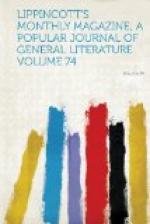for any intelligent observer to handle, weigh and test
every quality of the air, it became evident that wind
and storm, even the terrible cyclone, were not irresponsible
forces, carrying health or death to and fro where
they listed, but the result of plain, immutable; laws.
It was an American in this our Quaker City who reduced
the wind to a commonplace effect of a most ordinary
cause. Franklin, one winter’s day passing
with a lighted candle out of a warm room into a cold
one, saw that as he held it above his head the flame
was blown outward before him: when he held it
near the floor, the flame was blown into the room.
The shrewd observer stood in the doorway, instead
of hurrying out, as most of us would have done, to
save the wasting candle. The warm air in the heated
room, he conjectured, was expanded by the heat, consequently
it rose as high as it could, and made a way for itself
out of the room at the upper part of the doorway,
while the heavier cold air from without rushed in
below to fill the vacated space. What if he took
the equatorial regions or great tracts of arid desert
for the heated room? The air over them, subjected
by the heat to constant rarefaction, must rise, must
overflow above, and must force the colder air from
the surrounding regions in below. Two sheets
of air will thus set in vertically on both sides,
rise, and again separate above. Here was an explanation
of the great, steady, uninterrupted aerial currents
which, at the rate of from fifteen to eighteen miles
per hour, sweep the surface of the Atlantic and Pacific
oceans. The candle, no doubt, was wasted, but
the secret of the trade-winds was discovered.
The idea was correct as far as it went. It did
not go very far, it is true. It had not taken
into account the earth’s rotation, whose force,
according to Herschel, “gives at least one-half
of their average momentum to all the winds which occur
over the whole world;” nor the infinite variation
in the movements of the atmosphere which we call winds,
caused by the change in the sun’s motion, by
the differing amounts of vapor held in them, by the
physical configuration of the earth below, by the
vicinity of the sea or arid deserts, and by the passage
of storms or electric currents.
The science of meteorology, especially as regards
wind, is as yet searching for general principles,
which can only be deduced from countless facts.
We do not now, like Saint Paul, talk of the wind Euroclydon
as of a special agent of God, but describe it by stating
that it is an aerial ascending current over the Mediterranean,
produced by the heated sands of Africa and Arabia.
We can even measure its heat at 200 deg. Fahrenheit,
and its velocity at fifty-four miles per hour.
But it attacks us just as unexpectedly as it did the
apostle, and brings disease and death to Naples or
Palermo to-day just as surely as it did to Cambyses.
The popular verdict on the matter would no doubt be
that when meteorologists can not only describe the




